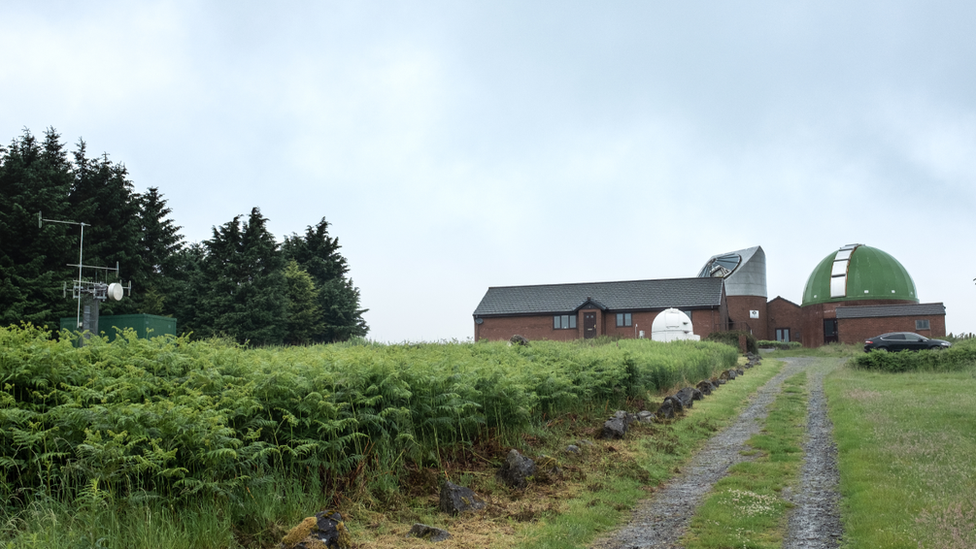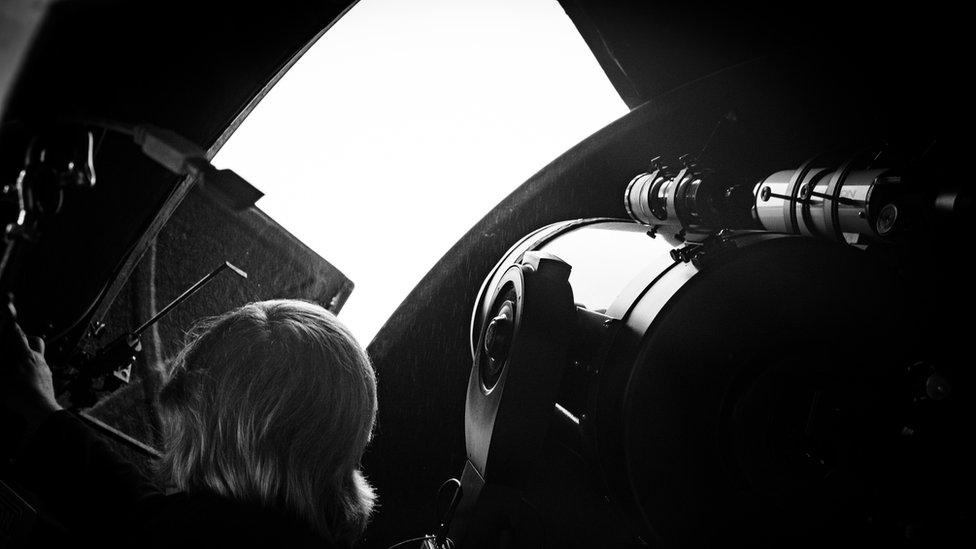Extinction events: The man helping protect earth
- Published
Jay Tate says "when – not if" the Earth is struck by a comet "the effects could be catastrophic"
Perched on top of a remote, wind-swept hill in rural mid-Wales sits a series of structures designed to protect us against "one of the most significant risks to human civilisation".
The Spaceguard Centre, near Knighton, in Powys, is a working observatory which tracks "near-Earth objects" - comets and asteroids which could hit Earth.
Its director, Jay Tate, established the centre in 1997 after he became concerned at a lack of co-ordination in the UK and internationally to counter the threat.
Mr Tate said technology exists to be able to "nudge" comets and asteroids away from Earth if they are detected early enough.
The problem, for Mr Tate, is that not enough people take the threat seriously - to the average citizen and even those in power, it is a distant threat.
'Clear and present danger'

The centre has no external funding and relies on donations and the work of volunteers
A former officer in the British Army, where he specialised in missile systems, Mr Tate does not romanticise his work.
"This isn't really science. This is defence," he said.
"It's surveillance rather than science, and surveillance is a military function."
He became alarmed at the threat posed to humanity in 1994, when he watched through a telescope as a comet hit Jupiter.
"It seemed crystal clear to me that it was a clear and present danger, and that there would be systems in place. And there weren't."
After years of trying to push the issue up the agenda in military circles and in Whitehall, Mr Tate said he was told to "go away and shut up".
When, not if
He did not do as he was told - something he recalls with relish - and instead went about setting up the Spaceguard Centre, also known as the National Near Earth Objects Information Centre.
Now closed to tourists due to the coronavirus pandemic, the centre sits in a dark sky area about 1km (0.6 miles) from the English border.
Reachable only by driving along a farmer's track through a field full of sheep, it is an unlikely setting for such important work.

The observatory sits at the top of a hill in rural mid Wales
Unlike natural hazards like volcanoes and earthquakes, which are unpredictable, Mr Tate said comets and asteroids are "totally predictable".
"When, not if it happens, the effects could be catastrophic."
'Mass extinction'
Mr Tate said it would only take an asteroid the size of a cricket pitch to take out a city the size of London.
In 2013, he said the Russian city of Chelyabinsk avoided being "completely flattened, probably by a matter of four seconds" when a meteor broke up as people looked on in shock.
Eyewitnesses and CCTV cameras captured the moment the Chelyabinsk meteor flew across the sky
"If you go up in size to something like 500m across, that would take out a reasonable-sized country," he explained.
"If you go up to something a kilometre across, the effects would be global. Not a mass extinction, but civilisation as we know it would cease to exist.
"If you go up to 10km, you are talking about a mass extinction on a very large scale."
'We can fix this'
But it is not all doom and gloom. Mr Tate said the technology exists to detect, track and even divert these objects away from earth.
"This is a problem we can fix, it's avoidable," he explained.
"The point is it's very, very rare for your house to burn down, but you still take out insurance."

Mr Tate said he sees his work as more defence than science
Each day, the Minor Planet Centre, external (MPC) in the USA publishes a list of objects it would like to be monitored.
The Spaceguard Centre, like thousands of other observatories and amateur astronomers around the world, picks an object it is able to observe from the list.
It finds the area of space where the object should be located and takes three photographs.
Computers then analyse the photographs to find an object which is moving relative to the stars.
Calculations made by the computer can determine the object's orbit around the sun, which is sent back to the MPC.

The ability to deflect asteroids and comets relies on spotting them "years or decades" in advance of them hitting earth, Mr Tate says
There are a few ways of deflecting a comet or asteroid, Mr Tate explained, but all rely on the ability to find the object heading for Earth "years or decades" in advance.
That is because "you only have to deflect it a tiny amount to make it a near-miss".
Simpler methods involve hitting it with something, but Mr Tate said, while another option could be to detonate a nuclear bomb on its surface.
'Danger close'
When the meteor broke up above Chelyabinsk in 2013, "nobody saw it coming", Mr Tate said.
It was, in part, due to its small size (about 20m across), but also because observatories, including the Spaceguard Centre, had their telescopes trained elsewhere.
The other object was big enough to take out a "reasonable-sized continent", Mr Tate explained, and had passed between Earth and the moon - considered "danger close" in the business.
At the moment, Mr Tate said the centre is limited to simply tracking rather than finding objects - but this could soon change.

A telescope donated by Cambridge University in 2009 will allow the centre to find, rather than just track objects
In 2009, Cambridge University offered the centre one of its telescopes which was being decommissioned.
Mr Tate had nowhere to put the 7.5-tonne telescope, but thanks to a band of volunteers, it is now housed inside a custom-built dome.
Coronavirus has put a stop to vital work on the project, named Drax, so it could be years before it is ready.
Hearts and minds

Mr Tate admits one of his most important roles is to convince people of the project's urgency
But Mr Tate acknowledges his most important work might not be in the actual pursuit of comets and asteroids.
"One of our jobs is to persuade everyone else that this is important," he concluded.
"This hopefully won't happen in our lifetime, in the next century, in the next millennium. I don't know. If I did know, I would be happy.
"Point is it will happen, and when it does happen, life turns to pain in a very big way."
- Published28 June 2020

- Published20 April 2020

- Published12 September 2019

- Published9 February 2018
